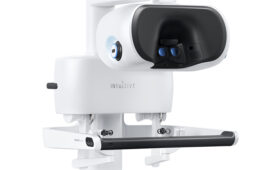Delivering human-centered healthcare solutions means thinking about the total user experience from start to finish. Each design decision lies within a deeply interdependent, complex system, and the process of creating a seamless experience is complicated, too.
Ami Verhalen, Design Concepts

An experience map is a model to establish a shared understanding of various users’ experiences. [Image courtesy of Design Concepts]
Here’s a concrete example: A medical device company believed customers wanted their diagnostic instrument to work faster and tasked their R&D teams with creating speedier systems and technologies. After they had a complete experience map in hand, they learned that labs do indeed want faster results, but their instrument wasn’t the issue. The gap was in accessing the samples: collecting, labeling, entering the data and sample, and transferring it to the lab. This was a very different challenge, and this insight was a catalyst for the team. The map continually reinforced this big picture to keep everyone focused on meaningful priorities rather than assumptions.
Designing in a vacuum can lead to solutions that are isolated and cause issues or embarrassing oversights. Mapping can help a team set priorities so that it delivers thoughtful, integrated solutions that show you understand the users’ whole experience and your organization’s ability to deliver. By creating detailed maps, the project team has a full understanding when it chooses to focus on one area over another.
Maps also provide an understanding of contextual and systemic implications, guiding the team in identifying gaps and pain points and how new solutions must integrate to succeed. These maps may be created from existing data, information and hypotheses, but you will need to do some research along the way to get additional accurate information. This will inform proportion and importance on the map, so that you can derive meaning.
Experience map
The most critical type of map is an experience map, which is a model to establish a shared understanding of various users’ experiences. It visually illustrates the steps in the processes, the journeys of various users and the interconnectedness of the overall experience. This map is most helpful for informing and inspiring design teams to create human-centered solutions. Key elements include:
- Users: All user types including 1) end users (patients, lab techs, maintenance); 2) influencers (sales staff, channels, payers, the FDA); and 3) decision makers (lab manager, hospital CEO, group purchasing organization)
- Tasks: Everything along their work process, including how users acquire, use, store, re-use and dispose of products and tools. Over time, this may include daily, weekly, monthly, annual or seasonal variations.
- Tools: The hardware, software, information, commodities and communication tools used throughout the experience and workflows, such as devices, middleware, electronic medical records and patient information.
- Environments: All the environments in which users may work and where their tools and systems may reside, including offsite and remote locations and virtual environments.
Across the map, these elements should:
- Show progress over time;
- Represent scale or proportion of the experience’s stages relative to one another;
- Signal the interconnectedness of the various elements.
For medical devices, a simple list of key map elements becomes a complex system very quickly, and your team will find it invaluable.
However, if you need a catalyst to inform human and business-centered implementation, you may find this next type of map – a service blueprint – to be very valuable.
Service blueprint
A service blueprint is a model that captures an organization’s systems, which must be in place to ensure the product can be delivered, as well as the users’ interactions and workflow. The key elements of a service blueprint include people, props, places, partnerships and processes. Using such a map allows teams to understand the execution requirements and provides cues to potential resource and process needs within an organization.
Maps are only effective when your team has insights that highlight each element’s pain points, gaps and interdependencies. Use this information to identify opportunities and set priorities that match your organization, your strengths and your project goal.
Ami Verhalen is VP of design at Design Concepts, a design and innovation consulting firm with offices in Madison, Wis., San Francisco and Boston.
The opinions expressed in this blog post are the author’s only and do not necessarily reflect those of Medical Design and Outsourcing or its employees.





Having read this I thought it was rather informative.
I appreciate you spending some time and effort to put this article together.
I once again find myself spending way too much time both reading and commenting.
But so what, it was still worth it!